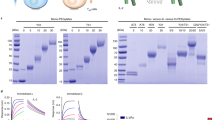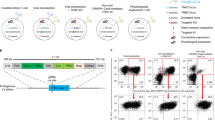Abstract
The chimeric cell surface receptor scC2Fv/CD8/ζ was constructed to engineer primary mouse T lymphocytes with antibody-type specificity to type II collagen (CII). Such cells could be used as gene carriers in the anti-inflammatory gene therapy of an autoimmune arthritis. This receptor includes the single chain Fv domain (scFv) of the anti-CII monoclonal antibody (mAb) C2, hinge region of CD8α and the transmembrane and cytoplasmic domains of TCRζ. The scC2Fv/CD8/ζ gene was transduced into T cell hybridomas and primary mouse lymphocytes using retrovirus-mediated gene transfer. The chimeric receptor scC2Fv/CD8/ζ forms covalently bound homodimers, as demonstrated in T cell hybridomas and packaging fibroblasts. It does not associate with endogenous signalling subunits of the TCR complex. When scC2Fv/CD8/ζ-expressing clones of T cell hybridomas MD.45 and HCQ6 were stimulated with CII they produced IL-2. The level of their IL-2 response correlated with the expression level of the chimeric receptor on the cell surface. Splenocytes isolated from DBA/1 mice were stimulated with Con A in vitro to facilitate retrovirus-mediated transfer of the scC2Fv/CD8/ζ gene. As a result of transduction, approximately 4% of the Con A-activated splenocytes expressed the chimeric receptor scC2Fv/CD8/ζ on the cell surface. These cells proliferated in response to stimulation with CII.
This is a preview of subscription content, access via your institution
Access options
Subscribe to this journal
Receive 12 print issues and online access
$259.00 per year
only $21.58 per issue
Buy this article
- Purchase on Springer Link
- Instant access to full article PDF
Prices may be subject to local taxes which are calculated during checkout







Similar content being viewed by others
References
Feldmann M, Elliott MJ, Woody JN, Maini RN . Anti-tumor necrosis factor-alpha therapy of rheumatoid arthritis Adv Immunol 1997 64: 283–350
Williams RO, Feldmann M, Maini RN . Anti-tumor necrosis factor ameliorates joint disease in murine collagen-induced arthritis Proc Natl Acad Sci USA 1992 89: 9784–9788
Williams RO, Ghrayeb J, Feldmann M, Maini RN . Successful therapy of collagen-induced arthritis with TNF receptor-IgG fusion protein and combination with anti-CD4 Immunology 1995 84: 433–439
Chernajovsky Y et al. Inhibition of transfer of collagen-induced arthritis into SCID mice by ex vivo infection of spleen cells with retroviruses expressing soluble tumor necrosis factor receptor Gene Therapy 1995 2: 731–735
Makarov SS et al. Suppression of experimental arthritis by gene transfer of interleukin 1 receptor antagonist cDNA Proc Natl Acad Sci USA 1996 93: 402–406
Kuruvilla AP et al. Protective effect of transforming growth factor beta 1 on experimental autoimmune diseases in mice Proc Natl Acad Sci USA 1991 88: 2918–2921
Bessis N et al. Attenuation of collagen-induced arthritis in mice by treatment with vector cells engineered to secrete interleukin-13 Eur J Immunol 1996 26: 2399–2403
Keystone E, Wherry J, Grint P . IL-10 as a therapeutic strategy in the treatment of rheumatoid arthritis Rheum Dis Clin North Am 1998 24: 629–639
Rabinovich GA et al. Recombinant galectin-1 and its genetic delivery suppress collagen-induced arthritis via T cell apoptosis J Exp Med 1999 190: 385–398
Robbins PD, Evans CH, Chernajovsky Y . Gene therapy for rheumatoid arthritis Springer Semin Immunopathol 1998 20: 197–209
Seabrook T et al. The traffic of resting lymphocytes through delayed hypersensitivity and chronic inflammatory lesions: a dynamic equilibrium Semin Immunol 1999 11: 115–123
Chernajovsky Y et al. Gene therapy for rheumatoid arthritis. Theoretical considerations Drugs Aging 1998 12: 29–41
Mageed RA et al. Prevention of collagen-induced arthritis by gene delivery of soluble p75 tumour necrosis factor receptor Gene Therapy 1998 5: 1584–1592
Moritani M et al. Prevention of adoptively transferred diabetes in nonobese diabetic mice with IL-10-transduced islet-specific Th1 lymphocytes J Clin Invest 1996 98: 1851–1859
Kramer R et al. Gene transfer through the blood–nerve barrier: NGF-engineered neuritogenic T lymphocytes attenuate experimental autoimmune neuritis Nature Med 1995 1: 1162–1166
Mathisen PM et al. Treatment of experimental autoimmune encephalomyelitis with genetically modified memory T cells J Exp Med 1997 186: 159–164
Shaw MK et al. Local delivery of interleukin 4 by retrovirus-transduced T lymphocytes ameliorates experimental autoimmune encephalomyelitis J Exp Med 1997 185: 1711–1714
Akhtar I et al. CD4+ beta islet cell-reactive T cell clones that suppress autoimmune diabetes in nonobese diabetic mice J Exp Med 1995 182: 87–97
Chen Y et al. Regulatory T cell clones induced by oral tolerance: suppression of autoimmune encephalomyelitis Science 1994 265: 1237–1240
Gua DJ, Hinton DR, Stohlman SA . Self-antigen-induced Th2 responses in experimental allergic encephalomyelitis (EAE)-resistant mice J Immunol 1995 155: 4052–4059
Kuchroo VK et al. B7–1 and B7–2 costimulatory molecules activate differentially the Th1/Th2 developmental pathways: application to autoimmune disease therapy Cell 1995 80: 707–718
Tan KN et al. Biological characteristics of an immunoregulatory activity secreted by an autoreactive CD4+ T cell clone that suppresses autoimmune diabetes in non-obese diabetic mice Int Immunol 1996 8: 689–699
Holmdahl R et al. Collagen induced arthritis: an experimental model for rheumatoid arthritis with involvement of both DTH and immune complex mediated mechanism Clin Exp Rheum 1989 7 (Suppl. 3): 51–55
Brocker T, Peter A, Traunecker A, Karjalainen K . New simplified molecular design for functional T cell receptor Eur J Immunol 1993 23: 1435–1439
Holmdahl R et al. Characterisation of the antibody response in mice with type II collagen-induced arthritis, using monoclonal ant-type II collagen antibodies Arth Rheum 1986 29: 400–410
Reth M . Antigen receptor tail clue Nature 1989 338: 383–384
Samelson LE, Klausner RD . Tyrosine kinases and tyrosine-based activation motifs J Biol Chem 1992 267: 24913–24916
Romeo C, Amiot M, Seed B . Sequence requirements for induction of cytolysis by the T cell antigen/Fc receptor ζ chain Cell 1992 68: 889–897
Annenkov AE et al. Loss of original antigenic specificity in T cell hybridomas transduced with a chimeric receptor containing single-chain Fv of an anti-collagen antibody and Fc epsilonRI-signaling gamma subunit J Immunol 1998 161: 6604–6613
Leo O et al. Identification of a monoclonal antibody specific for a murine T3 polypeptide Proc Natl Acad Sci USA 1987 84: 1374–1378
Michaelsson E et al. Macrophages, but not dendritic cells, present collagen to T cells Eur J Immunol 1995 25: 2234–2241
Bonifacino JS et al. Subunit interactions within the T-cell antigen receptor: clues from the study of partial complexes Proc Natl Acad Sci USA 1988 85: 6929–6933
Blumberg RS et al. Structure of the T-cell antigen receptor: evidence for two CD3 epsilon subunits in the T-cell receptor-CD3 complex Proc Natl Acad Sci USA 1990 87: 7220–7224
Davis MM et al. Ligand recognition by alpha beta T cell receptors Ann Rev Immunol 1998 16: 523–544
Mallender WD, Carrero J, Voss EJ . Comparative properties of the single chain antibody and Fv derivatives of mAb 4-4-20. Relationship between interdomain interactions and the high affinity for fluorescein ligand J Biol Chem 1996 271: 5338–5346
Kaufman Y, Berke G, Eshhar Z . Cytotoxic T lymphocyte hybridomas that mediate specific tumor-cell lysis in vivo Proc Natl Acad Sci USA 1981 78: 2502–2506
Brunsberg U et al. Expression of transgenic class II Ab gene conferes susceptibility to collagen-induced arthritis Eur J Immunol 1994 24: 1698–1702
Markowitz D, Goff S, Bank A . A safe packaging line for gene transfer: separating viral genes on two different plasmids J Virol 1988 62: 1120–1124
Brocker T, Karjalainen K . Signals through T cell receptor-zeta chain alone are insufficient to prime resting T lymphocytes J Exp Med 1995 181: 1653–1659
Dranoff G et al. Vaccination with irradiated tumor cells engineered to secrete murine granulocyte–macrophage colony-stimulating factor stimulates potent, specific, and long-lasting anti-tumor immunity Proc Natl Acad Sci USA 1993 90: 3539–3543
Chernajovsky Y et al. Pathogenic lymphoid cells engineered to express TGF β1 ameliorate desease in a collagen-induced arthritis model Gene Therapy 1997 4: 553–559
Morgenstern JP, Land H . Advanced mammalian gene transfer: high titre retroviral vectors with multiple drug selection markers and a complementary helper-free packaging cell line Nucleic Acids Res 1990 18: 3587–3596
Bahnson AB et al. Centrifugal enhancement of retroviral mediated gene transfer J Virol Meth 1995 54: 131–143
Ledbetter JA, Herzenberg LA . Xenogeneic monoclonal antibodies to mouse lymphoid differentiation antigens Immunol Rev 1979 47: 63–90
Miller EJ . Structural studies on cartilage collagen employing limited cleavage and solubilisation with pepsin Biochemistry 1972 11: 4903–4909
Acknowledgements
We thank Drs Thomas Broker for donating the plasmid p2δRICD8-ζ and Marco Londei for critically reading the manuscript. This work was supported by the Arthritis Research Campaign and Multiple Sclerosis Society, United Kingdom.
Author information
Authors and Affiliations
Rights and permissions
About this article
Cite this article
Annenkov, A., Chernajovsky, Y. Engineering mouse T lymphocytes specific to type II collagen by transduction with a chimeric receptor consisting of a single chain Fv and TCR zeta. Gene Ther 7, 714–722 (2000). https://doi.org/10.1038/sj.gt.3301149
Received:
Accepted:
Published:
Issue Date:
DOI: https://doi.org/10.1038/sj.gt.3301149
Keywords
This article is cited by
-
Technology Insight: gene transfer and the design of novel treatments for rheumatoid arthritis
Nature Clinical Practice Rheumatology (2006)
-
T-cell engineering by a chimeric T-cell receptor with antibody-type specificity for the HIV-1 gp120
Gene Therapy (2005)
-
Gene therapy for autoimmune diseases: quo vadis?
Nature Reviews Immunology (2004)
-
Gene therapy for arthritis
Gene Therapy (2003)
-
Celiac Disease: a model autoimmune disease with gene therapy applications
Gene Therapy (2003)



